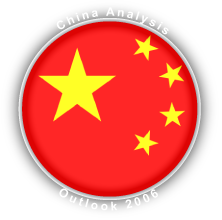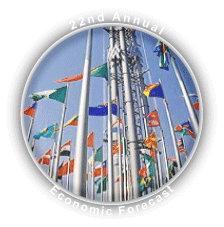Mobile Phones a Plum Market for Apple—If It Changes the Rules
 As mobile phones and smartphones become increasingly commonplace in mature and emerging markets, pundits increasingly predict that Apple will apply its design and experience expertise to field a mobile phone. Renowned for the elegance and simplicity of its devices and services, Apple provides unparalleled experience through world-class design of hardware, software and services. It delights and inspires customers by making the complex simple and beautiful. As mobile phones and smartphones become increasingly commonplace in mature and emerging markets, pundits increasingly predict that Apple will apply its design and experience expertise to field a mobile phone. Renowned for the elegance and simplicity of its devices and services, Apple provides unparalleled experience through world-class design of hardware, software and services. It delights and inspires customers by making the complex simple and beautiful.
The market for computing devices, wireless access and information (content) is at the point of convergence, and its value chain players—access providers, device makers and information providers—are vying to grow their influence. The digital device is rapidly becoming the hub for an unlimited number of information services. For many people, it is the main access device to the Internet, more than a computer. Within the market for devices, smartphones represent the convergence of PDAs and phones.
But the market for “music phones” is crippled by intractable value chain conflict. Can Apple use its core competency to create sustainable competitive advantage by changing the rules?
Are Rumors Grounded in a Solid Business Case?
The never-ending […]
![Bank Wins Web 0.2 Citation for Delivering "Yechsperience" [customer experience satire]](http://rollyson.net/wp-content/uploads/2007/03/webdot2-logo.png) (**Updated) Marketing Outlays Sabotaged by Sub-par Process Execution (**Updated) Marketing Outlays Sabotaged by Sub-par Process Execution
Chicago, 29 November 2006—Today, the Global Human Capital Journal awarded Grace Bank, the top three credit card issuer, its notorious Web 0.2 Citation for inducing an acute spasm of customer yechsperience™.
This citation demonstrates how exceptionally poor service destroys brand despite kind words and happy pictures from Marketing. Although Grace employed a somewhat formulaic approach, it demonstrated laudable skill at producing customer irritation and angst.
[…]
Peter Sondergaard opened the analyst firm’s vaunted annual Symposium/ITxpo this week by admonishing CIOs to prepare for a consumer shift that will reverse the current state in which business and government control customer and constituent relationships. As reported by eWeek, Gartner’s head of global research didn’t pull any punches: businesses will have to earn the right to justify premium offerings by empowering consumers:
 “The impact of consumerization is the most important trend impacting IT in the next 10 years,” Sondergaard remarked. “There will be a shift in culture reflecting the dominance of the ‘digital natives.’ Consumer technology will be integrated into (the) home, home office, in transit or recreational areas, and users will initiate interactions from all of these settings.” “The impact of consumerization is the most important trend impacting IT in the next 10 years,” Sondergaard remarked. “There will be a shift in culture reflecting the dominance of the ‘digital natives.’ Consumer technology will be integrated into (the) home, home office, in transit or recreational areas, and users will initiate interactions from all of these settings.”
[…]
If you have started to get the feeling that something new and big is afoot in the consumer Web world, no, you’re not having flashbacks to 1997
 Web 2.0 is a new phenomenon that is beginning to realign the balance of power between producers/providers of products/services and customers because it enables customers to self-organize and wield unprecedented influence in the market. “Web 2.0” refers to a group of (usually) free user-friendly Web applications like blogs, wikis, integrated video/phone services and social networking sites (more below) that enable individuals to connect, collaborate and concatenate with unprecedented ease. E-Commerce (doesn’t it sound quaint now?) first enabled consumers to gain a new level of information about products and services and, as adoption proceeded, to buy over the Web. That was “Web 1.0” and it was still largely one-way communication because information flowed from the Web to customers. “Web 2.0” is focused on letting individuals self-organize, interact, collaborate and be equal players in what aficionados call “the conversation” of the Web. Web 2.0 is a new phenomenon that is beginning to realign the balance of power between producers/providers of products/services and customers because it enables customers to self-organize and wield unprecedented influence in the market. “Web 2.0” refers to a group of (usually) free user-friendly Web applications like blogs, wikis, integrated video/phone services and social networking sites (more below) that enable individuals to connect, collaborate and concatenate with unprecedented ease. E-Commerce (doesn’t it sound quaint now?) first enabled consumers to gain a new level of information about products and services and, as adoption proceeded, to buy over the Web. That was “Web 1.0” and it was still largely one-way communication because information flowed from the Web to customers. “Web 2.0” is focused on letting individuals self-organize, interact, collaborate and be equal players in what aficionados call “the conversation” of the Web.
Before you B2B-focused readers yawn and turn the page, consider that this will turn […]
Dr. Clotaire Rapaille served a delectable elixir to a packed room of B2B marketers at BIGfrontier yesterday. His talk spanned business in China, investing in India, a new value proposition for shampoo (think “breastfeeding”), why people drive Hummers to the mall, why French people don’t work and myriad others. Rapaille (“Rah pEYE”) lists half of the Fortune 100 has retained clients because he has a track record with helping them understand the inner structures of consumers’ minds and, therefore, how to communicate with them. Moreover, many of these inner structures hold true across cultures which can enable companies to develop offerings that will hold true globally. Sound impossible? Read on.
As usual, I will share my notes from the meeting and follow those with some of my insights but, unlike the usual custom, I have also interspersed some material from one of his major books to fill gaps. The topics he addressed were intricate and complex, and there wasn’t time to delve into the details of the background research.
Background
Rapaille, a Frenchman who subsequently became virulently American, began his career as a psychoanalyst working with autistic children in Switzerland, which gave him insights into how the brain worked and […]
Jim Champy, author of many management bestsellers, including Reengineering the Corporation, led a fascinating discussion 18 April 2006 at Chicago’s Standard Club, sponsored by Perot Systems. Beginning with the presentation, “Doing Business in a Flat World: An Exploration of the Next Era in Globalization,” Jim gave attendees an invaluable perspective on how executives needed to reengineer reengineering for the knowledge economy. He highlighted past transformational efforts in the industrial economy (the original reengineering) and focused on how to achieve change in the knowledge economy. As usual, I will summarize key points of the discussion first and follow up with my insights.
Reengineering: 20th Century
In the 80s and 90s, reengineering helped businesses improve their business processes. For example, an insurance company regularly required 24 days to issue a policy because 13 departments were involved, each of which had optimized processes for itself, not the enterprise (or the customer). In fact, to issue the policy took ten minutes of actual work; the rest was administrative time. Today, business models of the industrial era are becoming obsolete, but most companies haven’t yet changed how they manage their businesses. A default method of drastic organization change, often employed by IBM and many others, […]
China Analysis and Outlook 2006 reveals an emerging opportunity to rebalance economic and political influence.
 Part II of the 2006 Economic Forecast featuring David Hale (presented Part I) and Lyric Hughes-Hale. Here, I present my notes of Lyric’s talk, followed by my observations. Part II of the 2006 Economic Forecast featuring David Hale (presented Part I) and Lyric Hughes-Hale. Here, I present my notes of Lyric’s talk, followed by my observations.
Background: China’s development and situation are far more complex than U.S. news sources report. It has seen significant economic liberalization during the past 25 years, and it shows every sign of continuing on that trajectory. However, the country is politically conservative. There is no freedom of the press. That said, the authoritarian government may produce reform much more quickly than if China had been democratic because the democratic process often slows reform. China is far more open and engaged on the world stage than it has been in many years. […]

SMA 21st Annual Economic Forecast 2006 is my coverage of the SMA/Harvard Club annual confab featuring David Hale and Lyric Hughes-Hale
The Strategic Management Association and The Harvard Club jointly sponsored the Economic Forecast 2006 featuring David Hale and Lyric Hughes-Hale. David presented his encyclopedic knowledge and perspective on global economic trends, while Lyric shared her insights on China in Part II of the evening (she was the founder of China Online and has focused on China for several years.).
As usual, I present my notes, followed by my insights. Here are my notes from David’s presentation (Part I of the meeting).
[…]
Surprises in the Emerging Chinese Consumer Market highlights the Internet-powered practice of consumer collaboration and group buying for discounts.
“Chinese Consumers Overwhelm Retailers with Team Tactics,” The Wall Street Journal, February 28, 2006 is a perfect example of how mature market assumptions can lead to surprises in emerging markets. Chinese consumers increasingly meet on the Internet chat rooms to plan and coordinate a group buying strategy for a type of good or even brand. Then they go to the retailer as a group to extract significant group discounts. This practice is known as tuangou, or team purchase, and can play havoc with companies’ pricing strategies and margins, to say the least.
[…]
The American Marketing Association Chicago Chapter held its Power Lunch round tables, 23 February 2006 in Chicago. I hosted Technology and Strategy tables, where marketing leaders from Fortune 1000 companies, startups and service providers exchanged impressions about emerging marketing trends and techniques. Here are my notes from the discussion.
[…]
|
|
 As mobile phones and smartphones become increasingly commonplace in mature and emerging markets, pundits increasingly predict that Apple will apply its design and experience expertise to field a mobile phone. Renowned for the elegance and simplicity of its devices and services, Apple provides unparalleled experience through world-class design of hardware, software and services. It delights and inspires customers by making the complex simple and beautiful.
As mobile phones and smartphones become increasingly commonplace in mature and emerging markets, pundits increasingly predict that Apple will apply its design and experience expertise to field a mobile phone. Renowned for the elegance and simplicity of its devices and services, Apple provides unparalleled experience through world-class design of hardware, software and services. It delights and inspires customers by making the complex simple and beautiful.
![Bank Wins Web 0.2 Citation for Delivering "Yechsperience" [customer experience satire]](http://rollyson.net/wp-content/uploads/2007/03/webdot2-logo.png) (**Updated) Marketing Outlays Sabotaged by Sub-par Process Execution
(**Updated) Marketing Outlays Sabotaged by Sub-par Process Execution  “The impact of consumerization is the most important trend impacting IT in the next 10 years,” Sondergaard remarked. “There will be a shift in culture reflecting the dominance of the ‘digital natives.’ Consumer technology will be integrated into (the) home, home office, in transit or recreational areas, and users will initiate interactions from all of these settings.”
“The impact of consumerization is the most important trend impacting IT in the next 10 years,” Sondergaard remarked. “There will be a shift in culture reflecting the dominance of the ‘digital natives.’ Consumer technology will be integrated into (the) home, home office, in transit or recreational areas, and users will initiate interactions from all of these settings.” Web 2.0 is a new phenomenon that is beginning to realign the balance of power between producers/providers of products/services and customers because it enables customers to self-organize and wield unprecedented influence in the market. “Web 2.0” refers to a group of (usually) free user-friendly Web applications like blogs, wikis, integrated video/phone services and social networking sites (more below) that enable individuals to connect, collaborate and concatenate with unprecedented ease. E-Commerce (doesn’t it sound quaint now?) first enabled consumers to gain a new level of information about products and services and, as adoption proceeded, to buy over the Web. That was “Web 1.0” and it was still largely one-way communication because information flowed from the Web to customers. “Web 2.0” is focused on letting individuals self-organize, interact, collaborate and be equal players in what aficionados call “the conversation” of the Web.
Web 2.0 is a new phenomenon that is beginning to realign the balance of power between producers/providers of products/services and customers because it enables customers to self-organize and wield unprecedented influence in the market. “Web 2.0” refers to a group of (usually) free user-friendly Web applications like blogs, wikis, integrated video/phone services and social networking sites (more below) that enable individuals to connect, collaborate and concatenate with unprecedented ease. E-Commerce (doesn’t it sound quaint now?) first enabled consumers to gain a new level of information about products and services and, as adoption proceeded, to buy over the Web. That was “Web 1.0” and it was still largely one-way communication because information flowed from the Web to customers. “Web 2.0” is focused on letting individuals self-organize, interact, collaborate and be equal players in what aficionados call “the conversation” of the Web. Part II of the 2006 Economic Forecast featuring David Hale (presented Part I) and Lyric Hughes-Hale. Here, I present my notes of Lyric’s talk, followed by my observations.
Part II of the 2006 Economic Forecast featuring David Hale (presented Part I) and Lyric Hughes-Hale. Here, I present my notes of Lyric’s talk, followed by my observations.